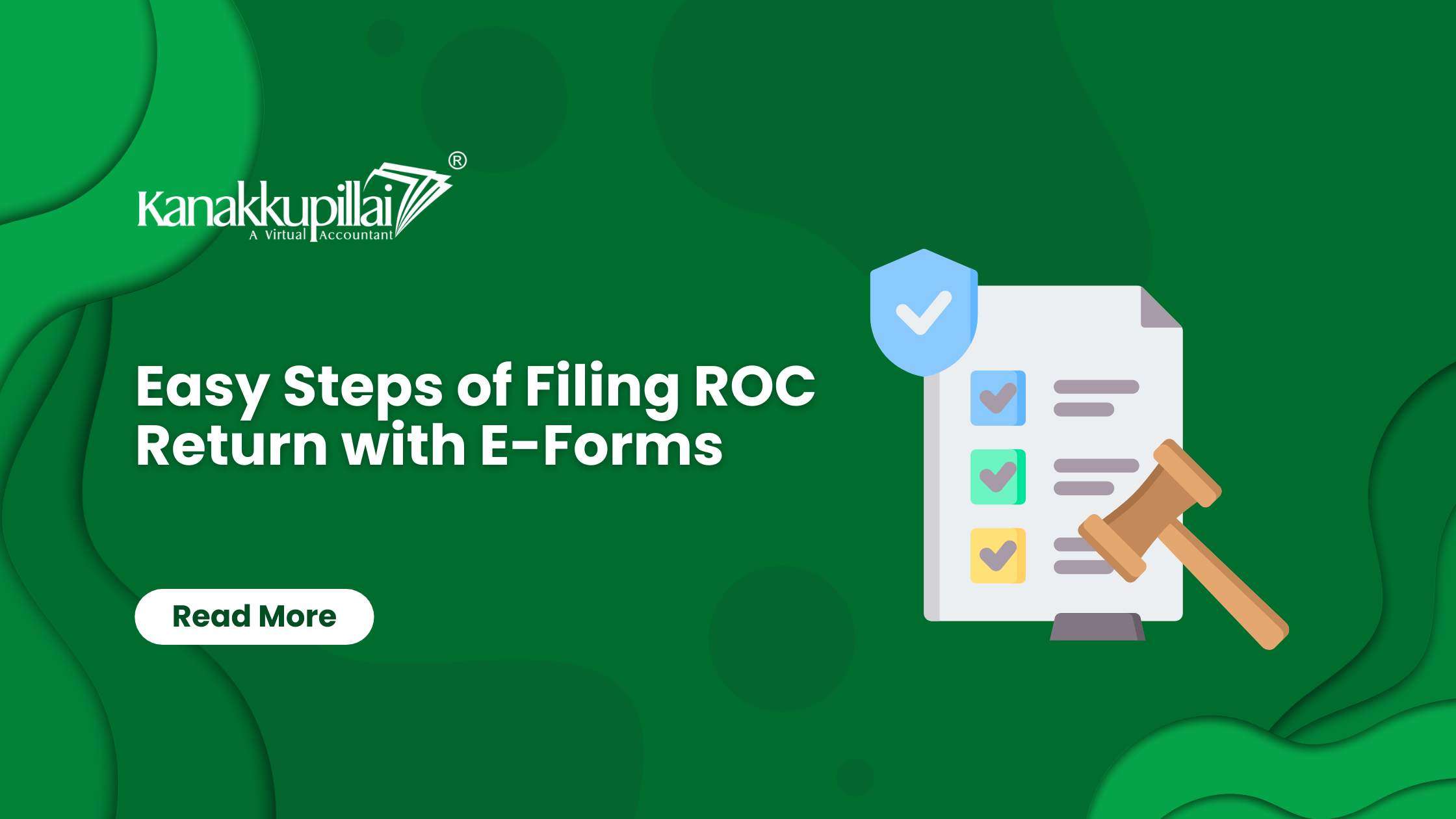![]()
The Companies Act of 2013 in India makes ROC submission, also known as Registrar of Companies submission, an essential legal requirement. It includes submitting various documents and forms to the Registrar of Companies to make clear that company control is lawful and transparent. To maintain precise financial records, communicate information about the business with associates, and obey the law, it is essential to file the ROC correctly.
Not following the rules for submitting with the ROC can lead to penalties and other legal consequences. Businesses must comprehend the importance of ROC filing to act properly, maintain their reputation, and obey the rules set by authorities in the business world.
Getting to Know ROC Filing
The Companies Act of 2013 specifies that companies need to submit ROC filings, which include examined financial accounts and annual reports, to the Registrar of Companies. Certain portions of the Companies Act, 2013, like Sections 129, 137, and 92, and rules that go with them, like Rule 12 of the Company Rules, 2014 and Rule 11 of the Companies Rules, 2014, regulate this entire procedure. ROC reporting is a very detailed process that starts with holding board meetings to give permission for financial statements to be made, finishing board reports, and having the Annual General Meeting pass important motions.
Compliance with ROC reporting dates is crucial as failure to stick to these requirements can lead to penalties, fines, or even the closure of the company, stressing the legal significance and effects of non-compliance. Moreover, ROC filing plays an important part in guaranteeing open financial reporting by compelling the submission of critical financial documents like balance statements and profit and loss summaries.
These statements not only provide stakeholders with an exhaustive overview of the company’s financial success but also enhance consumer trust and bolster the company’s trustworthiness. Following ROC filing not only safeguards companies from legal liabilities but also encourages access to business funding and loans by indicating financial stability and compliance with regulatory standards, highlighting the importance of cautious compliance with ROC filing legal responsibilities.
Steps for Filing ROC Return:
-
Hold Board Meetings:
To start the process of ROC reporting, the company must hold board meetings. During these meetings, the board authorises the preparation of financial records in accordance with Schedule III of the Companies Act. Additionally, the board authorises the Director or Company Secretary to write the Board Report and Annual Return as per the legal requirements. This step is important as it sets the basis for correct financial reports and openness in company government.
-
Conduct Annual General Meeting:
Following the board meetings, the company moves to hold the Annual General Meeting (AGM). During the AGM, important motions are passed, and the finalisation of financial accounts takes place. This step is important as it marks the official acceptance of the financial records, board reports, and yearly returns by the directors of the company. The AGM serves as a stage for owners to connect with the company’s financial success and strategy choices.
-
Document Preparation:
Document planning is a key part of ROC filing. Essential papers needed for ROC filing include the balance sheet, profit & loss account, and yearly return. These papers provide a thorough picture of the company’s financial health and success. Additionally, companies may need to file other forms like Form ADT-1 for the hiring of accountants and Form MGT-14 for motions approval. Ensuring the truth and thoroughness of these papers is vital to meeting legal standards and keeping openness in financial reporting.
By carefully following these steps, businesses can handle the ROC filing process successfully, ensuring compliance with legal laws, accurate financial reporting, and openness in corporate operations.
E-Forms and Attachments
E-forms play a crucial part in the ROC filing process, changing based on the type and size of the business. For instance, private limited companies need to file Form AOC-4 for the Profit & Loss Account, MGT 7 and MGT 7A for the Annual Return, and CRA 4 for the Cost Audit Report. Public Limited Companies, on the other hand, need to file these forms within 60 days of the Annual General Meeting (AGM), while One-Person Companies (OPCs) and Small Companies have different timelines. OPCs must file within 60 days from the AGM, and Small Companies have a 90-day window. These forms are important for maintaining compliance with the Companies Act of 2013 and ensuring open financial reporting.
The process of filling these forms involves careful attention to detail, respect for specific due dates, and correct entry of financial information. Companies must ensure prompt filing to escape fines and legal effects. Understanding the unique E-forms needed for different types of businesses, their goals, and the related due dates is crucial for successful ROC reporting and regulatory compliance.
ROC Filing Process with E-Form
Step-by-Step Process of Filing ROC Returns on the MCA Portal:
- Downloading Forms: Begin by visiting the MCA website and going to the Company E-filing area under MCA services. Download the necessary E-forms, such as AOC-4 for the Profit & Loss Account and MGT-7 for the Annual Return. Ensure that you have the latest copies of the forms needed for your business type.
- Filling Out E-Forms: After getting the forms, fill them out correctly with the important cash information and business data. Ensure that all areas are filled properly and that the information given matches with the financial records and legal standards of your business.
- Uploading Documents: Once the E-forms are filled out, attach the necessary PDF or XML documents as per the standards stated for each form. These papers usually include financial statements, balance sheets, profit & loss accounts, and safety records. Ensure that all files are full and accurate before continuing.
- Making Payments: After sending the forms and papers, the system will create a Service Request Number (SRN) and ask you to continue to the payment window. You have the choice to pay later and save the generated challan for future payment or make an instant payment using internet banking or debit/credit card services. Save the payment challan for reference.
- Tracking Transaction Status: Following payment, you can track the progress of your form by using the SRN under the MCA services page. Enter the SRN in the given space to track the progress of your ROC file. Regularly check for changes and ensure that your form is accepted within the stated timelines to keep compliance.
By following these step-by-step directions for filing ROC reports on the MCA site, you can handle the process quickly, ensure accurate entry of papers, and meet the legal requirements.
Importance of Timely Filing
Missing ROC filing dates can have serious effects, leading to legal issues and fines for businesses. Failure to file needed forms within the stated time frames can result in hefty fines, which increase based on the length of delay. The fines can range from two times the normal filing fee for delays up to 30 days to twelve times the normal filing fee for delays exceeding 180 days. Additionally, non-compliance with ROC filing dates can attract fees, possible closure of the company, and court actions. Timely reporting is crucial to avoid financial responsibilities, maintain regulatory compliance, and support the company’s legal position in line with the Companies Act 2013.
Benefits of ROC Filing
The benefits of ROC filing for companies, such as –
- Legal Compliance: ROC filing ensures companies stick to statutory requirements, avoiding fines and legal implications.
- Transparent Financial Reporting: By submitting correct financial accounts, companies promote trust among partners and show financial security.
- Access to Financing: Compliance with ROC laws improves trustworthiness, making it easier for businesses to receive loans and funds from financial institutions.
- Credibility Building: Maintaining ROC compliance displays ethical business practices, inspiring trust in investors, customers, and partners, leading to company growth and sustainability.
Common Challenges and Solutions in ROC Filing
Challenges:
- Lack of Understanding: Complex legal and business terms can lead to mistakes when filing.
- Missed Deadlines: Internal mishandling or unawareness may cause companies to overlook filing deadlines.
- Inaccurate Information: Providing wrong data in files can result in legal repercussions and damage the company’s image.
Solutions:
- Professional Assistance: Engage with experts like Chartered Accountants for correct advice.
- Timely Preparation: Begin plans well in advance to avoid missing deadlines.
- Thorough Verification: Conduct thorough studies of papers to ensure truth and compliance.
Conclusion
ROC filing is an essential component of corporate governance, ensuring legal compliance, open financial reporting, and access to funding for businesses. Properly submitting ROC forms not only reduces risks of fines and legal proceedings but also fosters confidence and trust among stakeholders. It is crucial for businesses that encourage compliance with ROC laws to keep ethical standards, maintain financial openness, and demonstrate dedication to regulatory requirements.
By emphasising the significance of accurate and rapid ROC filing, businesses can safeguard their operations, enhance their image, and encourage long-term survival in the fiercely competitive business climate. Compliance with ROC filing is not just an ethical responsibility but an important investment in the company’s growth and eventual achievement.





